| Columns Retired Columns & Blogs |
Considering all the different things it can do, the Anthem integrated is one of the "best bang for the buck" products ............
I measured the Anthem STR using my Audio Precision SYS2722 system (see the January 2008 "As We See It"). Before I test an amplifier, I precondition it with both channels driving a 1kHz tone at one-third power into 8 ohms for an hour. This thermally stresses an amplifier with a conventional class-AB output stage. At the end of the hour, the top panel was a warm 95.4°F (35.3°C), but the exposed tops of the internal heatsinks were too hot to touch, at 150.6°F (65.9°C). Even so, the STR has sufficient heatsinking for its rated power.
The analog inputs can be set either to be digitized at 32-bit/192kHz, in order to have the tone controls, crossover filtering, and Anthem Room Correction (ARC) available or to Analog Direct mode. With the Anthem's volume control set to "0.0," the maximum voltage gain at 1kHz into 8 ohms with an unbalanced input measured 37.2dB from the speaker terminals. Unusually, the balanced inputs offered a decrease in gain of 6dB rather than the usual increase of 6dB. Increasing the volume setting to "+7.0" increased the gain by exactly 7dB. Both balanced and unbalanced line inputs preserved absolute polarity (ie, were non-inverting), the balanced XLRs being wired with pin 2 hot. Both the balanced and unbalanced input impedances measured 20k ohms at all audio frequencies.
The output impedance was a low 0.07 ohm at 20Hz and 1kHz, rising slightly to 0.16 ohm at 20kHz. Consequently, the variation in the Anthem's frequency response with our standard simulated loudspeaker was very small (fig.1, gray trace). Other than into 2 ohms (green trace), there is a small peak at the top of the audioband, which correlates with a very slight, critically damped overshoot in the STR's reproduction of a 10kHz squarewave (fig.2). These two graphs were taken with the balanced inputs; the results were identical with the unbalanced inputs, and at all settings of the volume control.
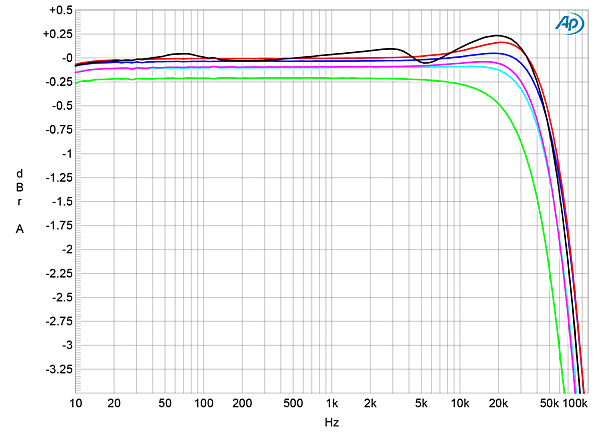
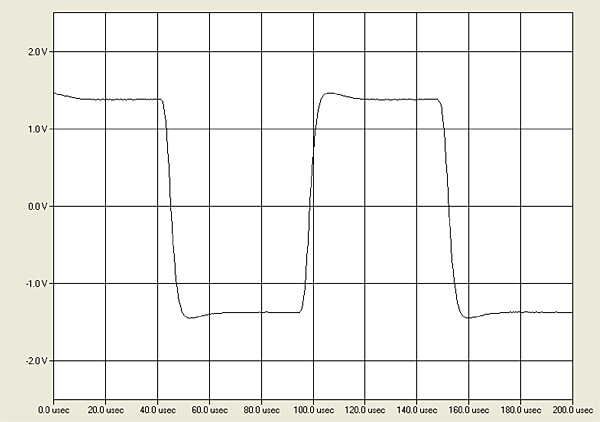
I reset the unbalanced input to digitize the signal and looked at the frequency response. I was at first puzzled by the result (fig.3), but then realized that Tom Norton had been using ARC and that its correction was active for this input, which was producing the boosts and cuts below 500Hz in this graph. I disabled ARC, then measured the effect of the STR's Bass and Treble controls set to their +10dB and –10dB positions (fig.4). The Bass control offers a range of ±10dB below 20Hz, the Treble control ±10dB above 20kHz. Channel separation was excellent, at 120dB R–L and 100dB R–L below 2kHz, and still 90dB in both directions at 20kHz. With the analog inputs shorted to ground and the volume control set to "0.0dB," the wideband, unweighted signal/noise ratio (ref. 2.83V into 8 ohms) measured 76.8dB. Restricting the measurement bandwidth to 22kHz increased the ratio to 83.7dB, and an A-weighting filter increased it further, to 86.4dB. (All ratios are the average of the two channels.) The primary source of noise was spectral components at the 60Hz AC power-line frequency and its odd-order harmonics (fig.5), these most likely due to magnetic interference from the large, centrally placed toroidal transformer.
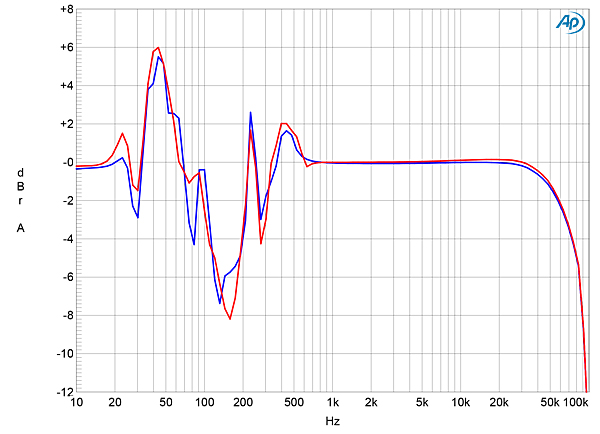
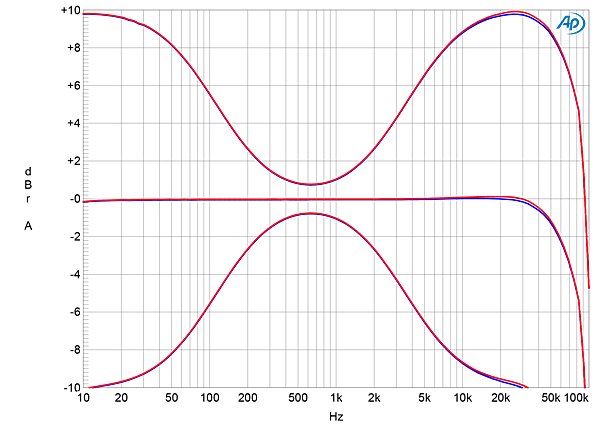
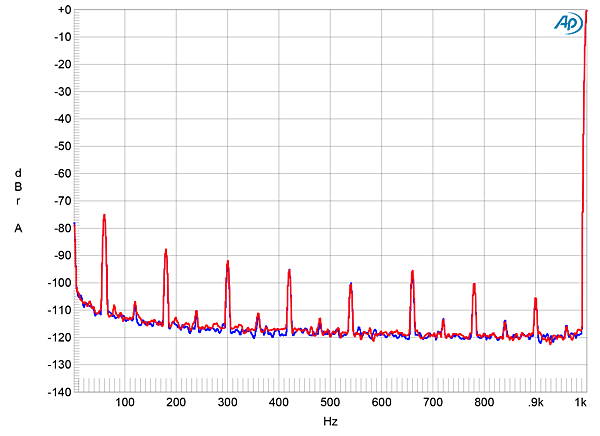
The STR is specified as delivering a maximum continuous output power of 200Wpc into 8 ohms (23dBW), 400Wpc into 4 ohms (23dBW), or 550Wpc into 2 ohms (21.4dBW). At our usual definition of clipping (ie, when the percentage of THD+noise in the amplifier's output reaches 1%), with continuous drive the STR delivered 225Wpc into 8 ohms (fig.6, 23.5dBW) and 375Wpc into 4 ohms (fig.7, 22.7dBW). The slight shortfall into 4 ohms is likely due to the fact that I don't hold the wall voltage constant during my testing; it had dropped from 120.6VAC with the amplifier at idle to 118.6V with the amplifier clipping into 4 ohms.
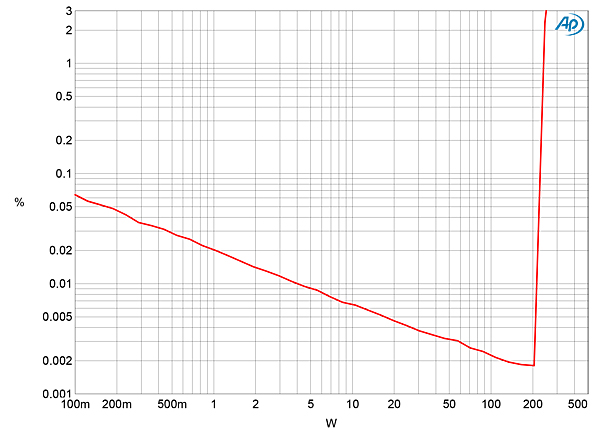
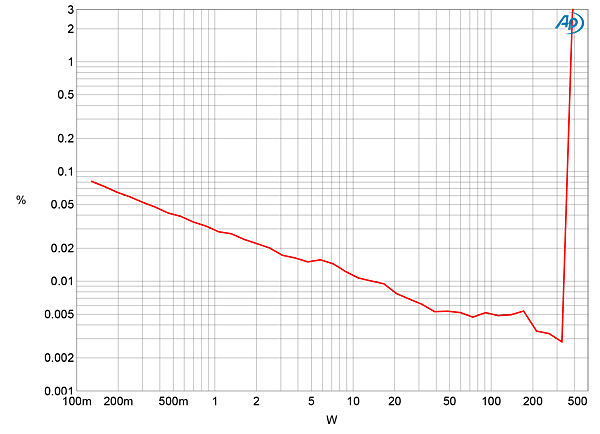
The shapes of the traces in these two graphs suggest that actual distortion is very low and lies below the noise floor at powers up to at least 100W. I therefore measured how the THD+N percentage changed with frequency at 20V output, equivalent to 50W into 8 ohms, 100W into 4 ohms, and 200W into 2 ohms (fig.8). Though the left channel (blue and cyan traces) is slightly more linear than the right (red, magenta) and there is the usual rise in the top octaves, the Anthem STR offers very low distortion. The distortion signature appears to be primarily second-harmonic in nature (fig.9), though the third harmonic was dominant in the left channel at high power into 4 ohms (fig.10, blue trace). Intermodulation distortion at high powers was relatively low, even at high powers into 4 ohms (fig.11).
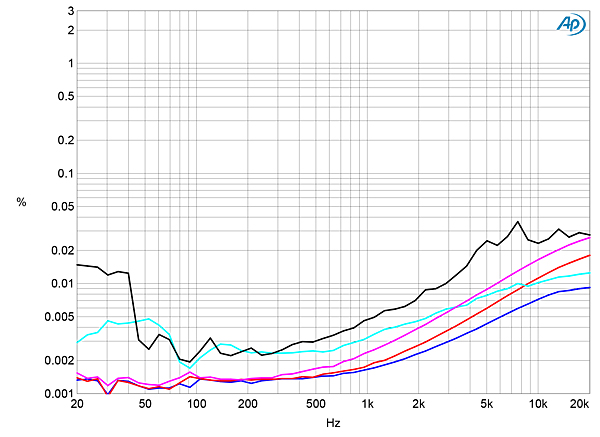
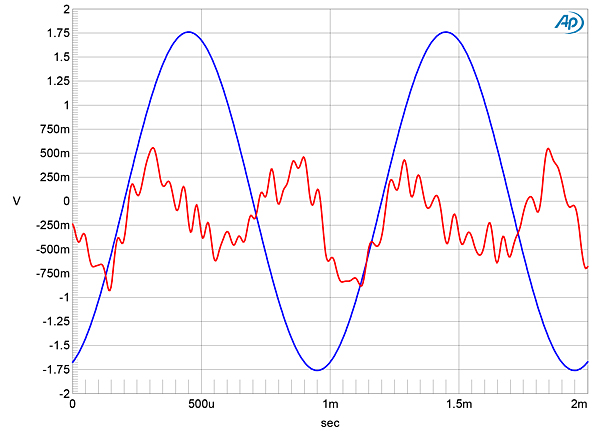
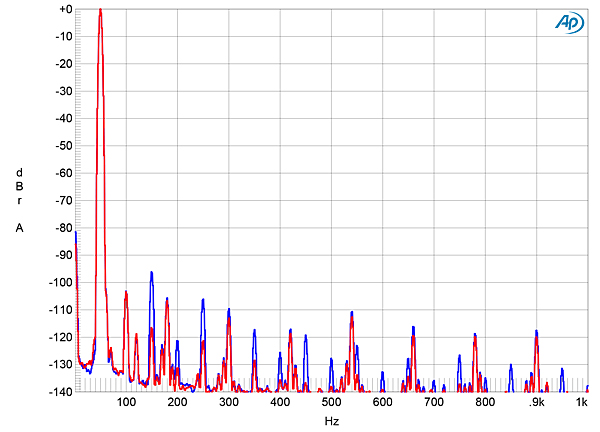
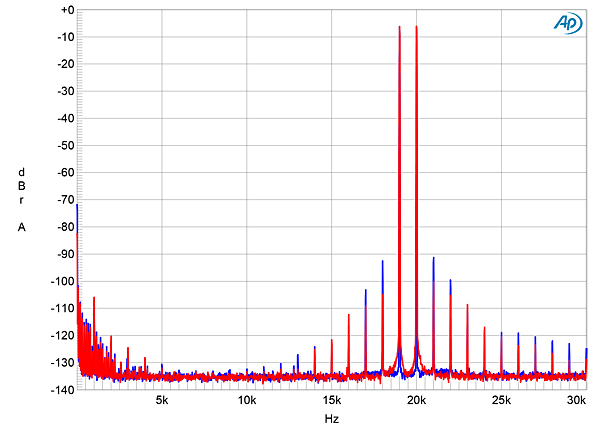
Both the MC and MM phono inputs preserve absolute polarity, and offer maximum gains of 72.2 and 91dB at the speaker outputs. The MC input impedance was the specified 100 ohms from 20Hz to 20kHz; the MM impedance was 44k ohms at 20Hz and 1kHz, dropping to 37k ohms at 20kHz. The RIAA equalization was superb and well matched between channels (fig.12). The MM input's audioband S/N ratio, ref. 1kHz at 5mV, was very good, at 67.5dB, this improving to 78.4dB when A-weighted. The MC input's S/N ratio was around 6dB lower, which is still very good considering the higher gain. Both phono inputs' overload margins were also excellent, at 26dB across the audioband (MM) and 19dB (MC), and both harmonic distortion and intermodulation distortion were extremely low.
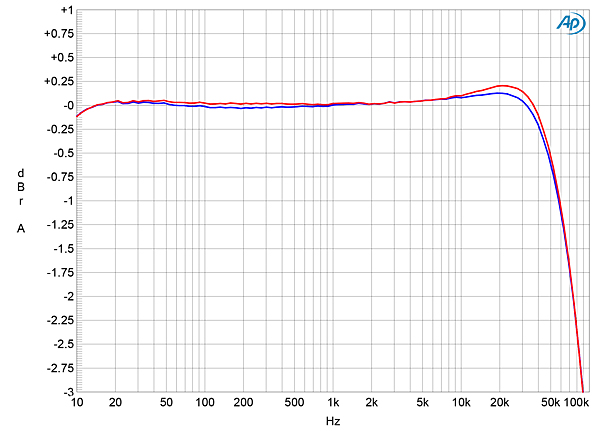
Turning to the digital inputs, the AES/EBU, coaxial, and optical TosLink inputs all locked to datastreams with all sample rates up to 192kHz. Apple's AudioMIDI app indicated that the USB input accepted 24-bit integer data with sample rates up to 384kHz. Apple's USB Prober utility identified the Anthem amplifier as the "STR USB Hi-Res Audio" from "XMOS," and indicated that its USB input operated in the optimal isochronous asynchronous mode. A 1kHz digital signal at 0dBFS resulted in an output level of 15.47V into 8 ohms with the volume control set to "–20.0," which suggests that the STR's gain with digital signals is a little too high.
The Anthem's impulse response with 44.1kHz data (fig.13) indicates that the reconstruction filter is a conventional linear-phase type, with time-symmetrical ringing to either side of the single sample at 0dBFS. With 44.1kHz-sampled white noise (fig.14, red and magenta traces) the STR's response rolled off sharply above 20kHz, reaching full stop-band suppression at just over half the sample rate (vertical green line). An aliased image at 25kHz of a full-scale tone at 19.1kHz (blue and cyan traces) can't therefore be seen. The distortion harmonics of the 19.1kHz tone all lie below –84dB (0.006%). With data sampled at 44.1, 96, and 192kHz, the response followed the same shape as the blue and red traces in fig.4, with sharp rolloffs below each Nyquist frequency (fig.15).
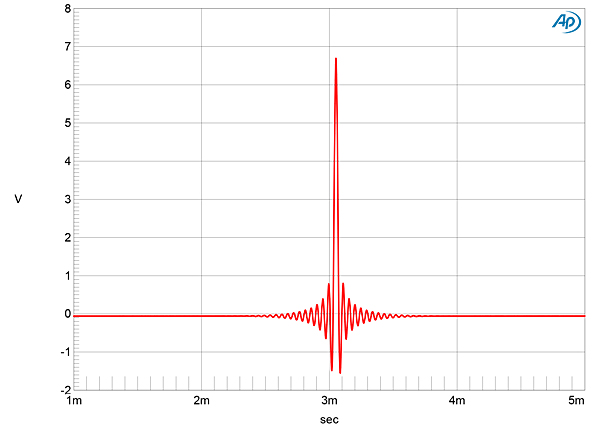
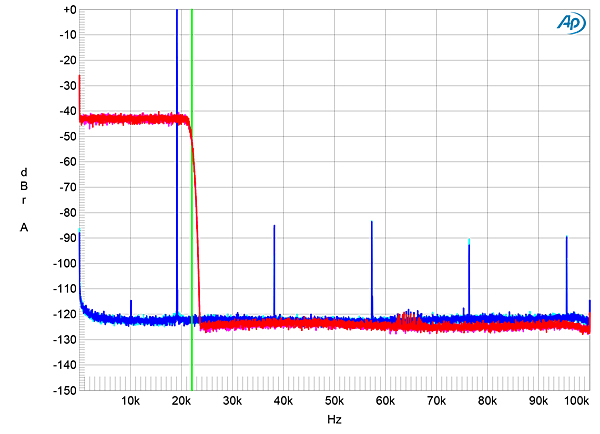
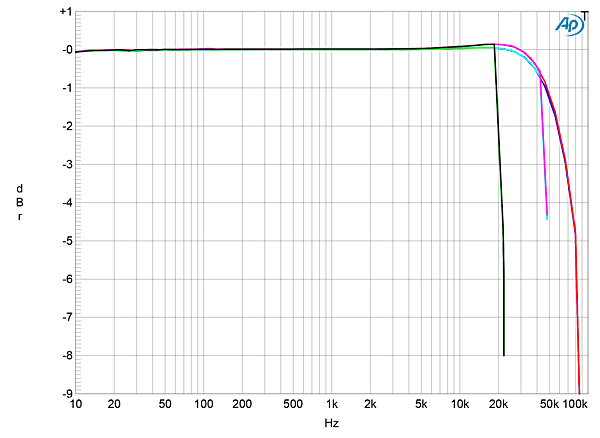
When I increased the bit depth from 16 to 24 with a dithered 1kHz tone at –90dBFS, the noise floor dropped by 13dB or so (fig.16), meaning that the STR offers at least 18 bits' worth of resolution. With undithered data representing a tone at exactly –90.31dBFS, the three DC voltage levels described by the data were well resolved and the waveform was perfectly symmetrical (fig.17).
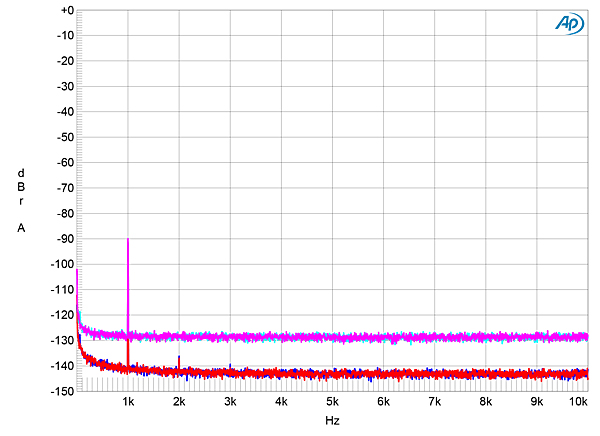

The STR's rejection of word-clock jitter with 16-bit AES/EBU data (fig.18) was superb, with all of the odd-order harmonics of the LSB-level, low-frequency squarewave at the correct levels (sloping green line). With 24-bit J-Test data (fig.19), no jitter-related sidebands were present above –130dB (0.00003%) via the AES/EBU, coaxial S/PDIF, and USB inputs.
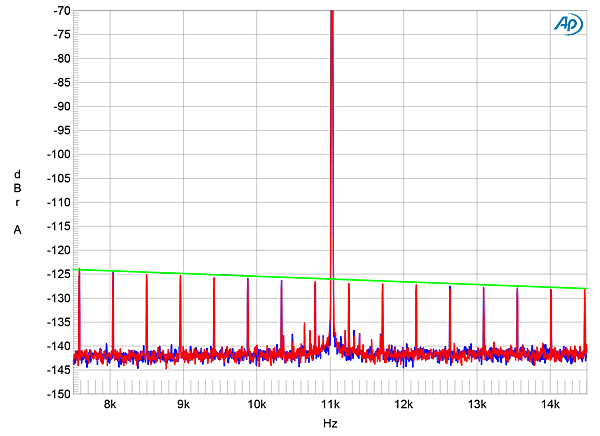
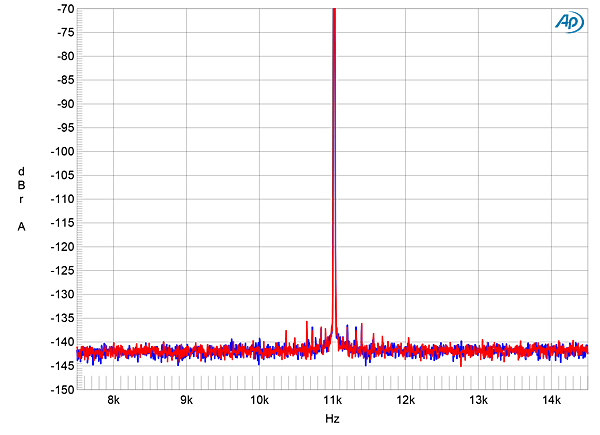
Anthem's STR is a well-engineered amplifier offering high power and respectable measured performance.—John Atkinson

Considering all the different things it can do, the Anthem integrated is one of the "best bang for the buck" products ............

for the big $$$ it better perform. Still I liked the brand better when it produced simple straightforward and more affordable products like the Integrated 225.

The average is not smoother, it's only averaged :)


"Get outta of my dreams, get into my car" :-) ............

Always wanted a pair of these great speakers. A few years ago someone was selling a pair with every replaceable woofer and tweeter as spares. Should have jumped on the chance. Nice to see Mr. Norton still using his.

This was a great review, but I really wish the reviewer had been given more opportunities to explore the features--no opinions on either of the phono inputs, no trying it out with even more high end speakers to see how it compares to integrated amps two or three times its price, etc. Seems like the reviewer was forced to review it based on a stereotype of Anthem as a home AV brand first, audiophile-brand second. I would have loved to see how it stacked up against a Mark Levinson or Pass Labs Integrated to see if it could hold its own.

I would also like to see how these integrated amps, in this relative price range, that have bass management/room correction (Anthem, Parasound, Outlaw, Classe) perform in a 2.1 configuration. I know a lot of stereo only folks that round out their systems with a subwoofer or two (including myself). I believe the only recent review of an integrated (receiver, actually) that incorporated subwoofers was that of the Arcam FMJ SR250, written by Mr. Rubinson

Dear Mr. Norton, thank you for your insightful review of the STR. I do believe you summed up the STR nicely. We feel that the Anthem STR is an excellent piece for the money with a very clean detailed presentation even without using ARC.
When you combine the STR's excellent power amplifier stage, a state of the art Room Correction system, a very capable dac stage, and a phono stage for a very reasonable $4,500.00 the STR should be on anyone's list to check out.
Howerver, the real shocker is the more expensive STR series amplifer and preamp/dac at $10k. The STR amplifier and preamp/dac just has an even more liquid overall presenation, while improving upon all aspects of the integrated amplifier.
You have to spend considerably more money than the STR separates to really move into higher quality sound, so the gentleman who asked about other brands, the new Anthem STR series products are really good sounding and are very competitive with any of the major audiophile brands.
Dave Lalin, owner, Audio Doctor NJ

I am trying to decide between these two to run a pair of 4 ohm speakers at 90db sensitivity. I use a Lumin D2 for streaming. What are your thoughts Dave?